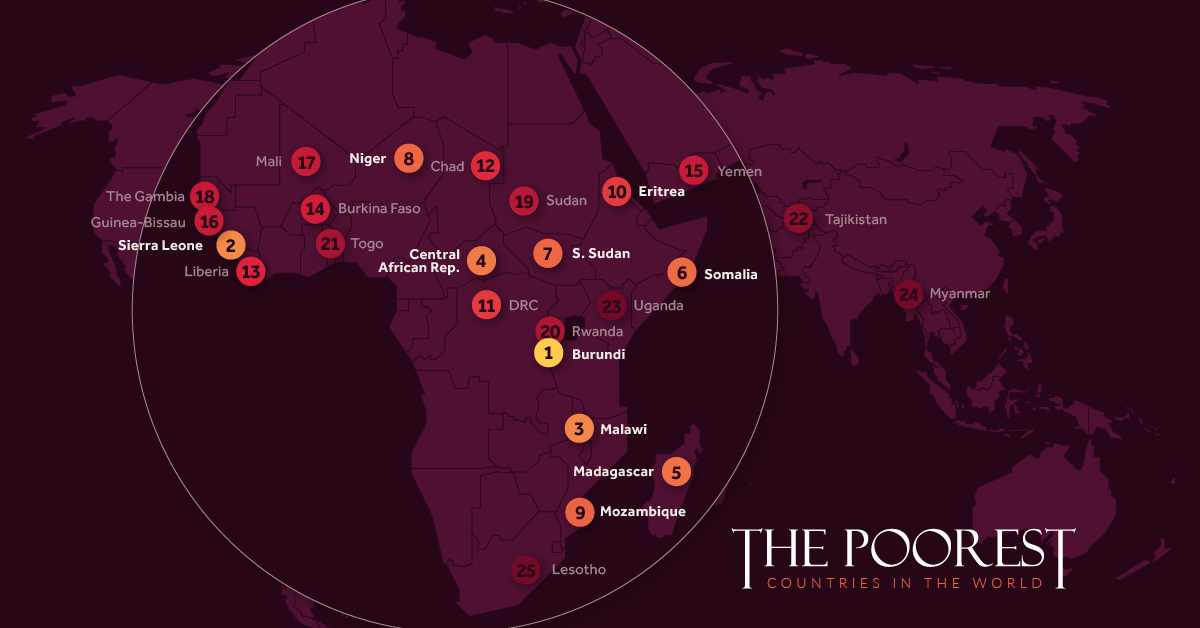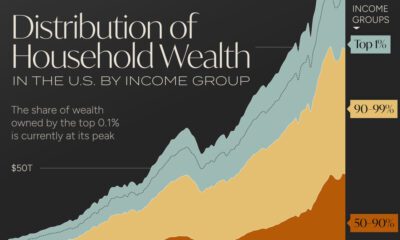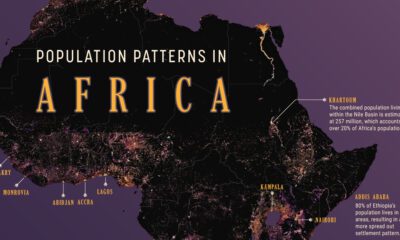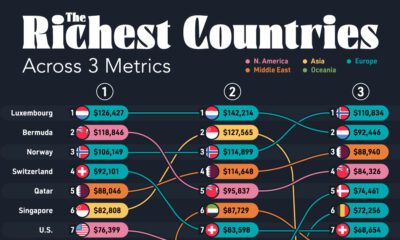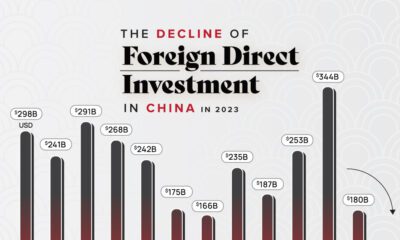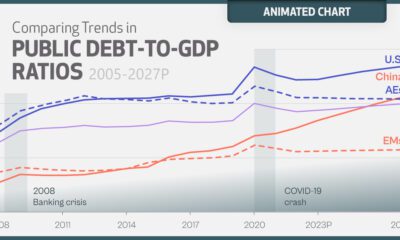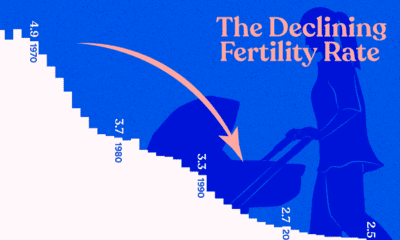Datastream
Ranked: The 25 Poorest Countries by GDP per Capita
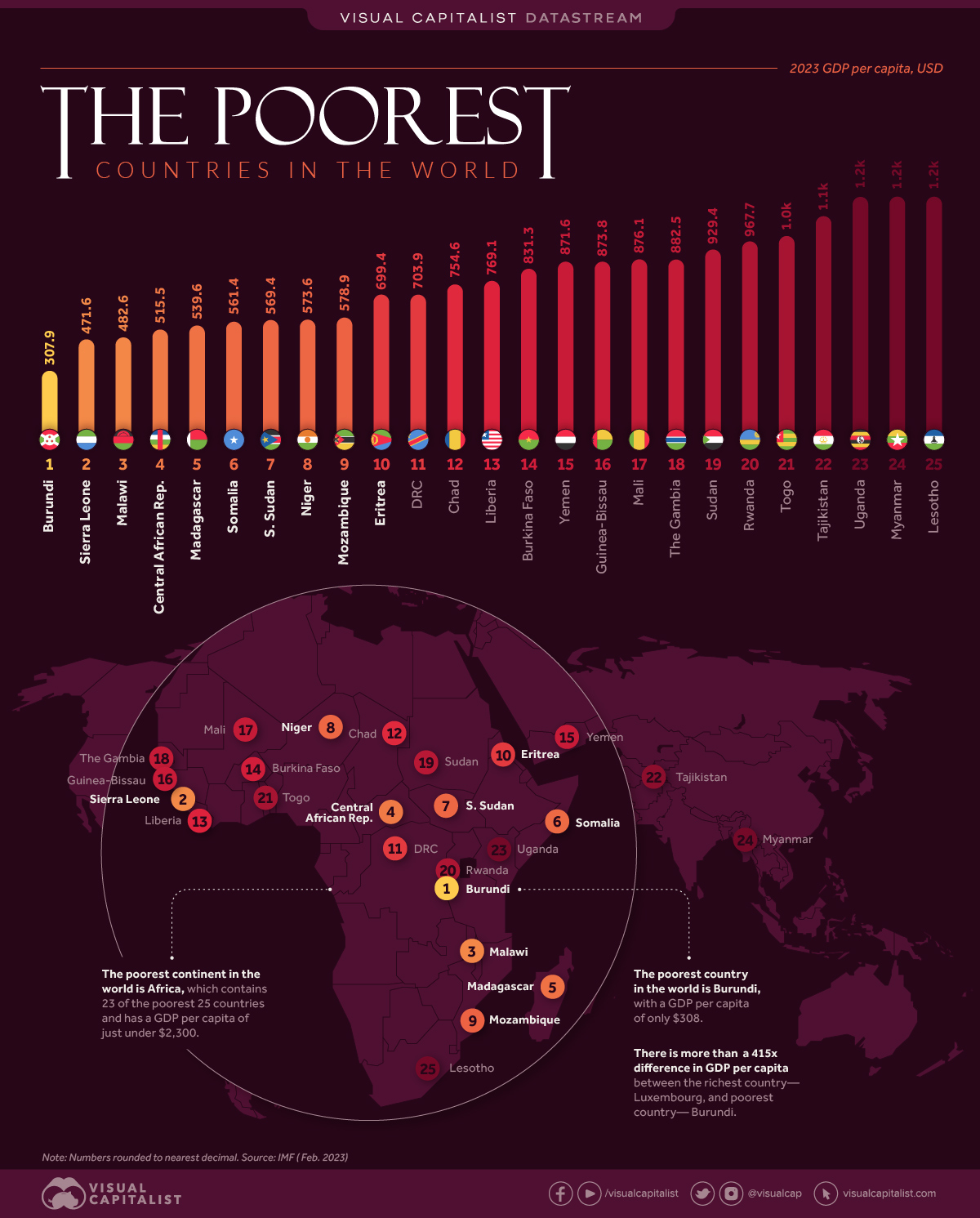
The Briefing
- Global GDP per capita continues to grow every year, and is projected to sit at $13,920 for 2023 (current prices)
- There are as many as 123 countries whose per capita GDP is below the global average
- Burundi is the poorest country in the world with a per capita GDP of about $308
Ranked: Which Are the World’s Poorest Countries?
There are different ways to measure economic activity and wealth of a country, and for this article on the world’s least-wealthy nations, we’ve used GDP per capita projections for this year from the International Monetary Fund (IMF).
Nominal world GDP per capita is expected to go from $13,400 in 2022 to $13,920 in 2023, but in contrast to the rest of the world, per capita economic output in Africa is much lower than in continents such as North America or Europe.
Here are the countries with the lowest per capita GDP, all below the global average.
| Country | GDP per capita (USD) |
|---|---|
| Burundi | $308 |
| Sierra Leone | $472 |
| Malawi | $483 |
| Central African Republic | $516 |
| Madagascar | $540 |
| Somalia | $562 |
| South Sudan | $570 |
| Niger | $574 |
| Mozambique | $579 |
| Eritrea | $700 |
| Congo | $704 |
| Chad | $755 |
| Liberia | $770 |
| Burkina Faso | $832 |
| Yemen | $872 |
| Guinea-Bissau | $874 |
| Mali | $877 |
| Gambia, The | $883 |
| Sudan | $930 |
| Rwanda | $968 |
| Togo | $1,008 |
| Tajikistan | $1,050 |
| Uganda | $1,164 |
| Myanmar | $1,173 |
| Lesotho | $1,209 |
| Ethiopia | $1,227 |
| Comoros | $1,303 |
| Tanzania | $1,341 |
| Nepal | $1,372 |
| Benin | $1,383 |
| Zambia | $1,396 |
| Guinea | $1,446 |
| Timor-Leste | $1,495 |
| Kyrgyz Republic | $1,570 |
| Cameroon | $1,609 |
| Senegal | $1,640 |
| Kiribati | $1,732 |
| Haiti | $1,792 |
| Cambodia | $1,902 |
| Lao P.D.R. | $1,985 |
| Ghana | $2,131 |
| Kenya | $2,259 |
| São Tomé and Príncipe | $2,302 |
| Zimbabwe | $2,308 |
| Solomon Islands | $2,330 |
| Mauritania | $2,366 |
| Côte d'Ivoire | $2,497 |
| Nicaragua | $2,541 |
| Uzbekistan | $2,555 |
| Nigeria | $2,585 |
| India | $2,692 |
| Congo | $2,844 |
| Bangladesh | $2,847 |
| Honduras | $3,080 |
| Vanuatu | $3,115 |
| Venezuela | $3,267 |
| West Bank and Gaza | $3,544 |
| Papua New Guinea | $3,570 |
| Cabo Verde | $3,709 |
| Tunisia | $3,762 |
| Philippines | $3,764 |
| Bolivia | $3,792 |
| Bhutan | $3,856 |
| Djibouti | $3,870 |
| Angola | $3,998 |
| Morocco | $4,068 |
| Samoa | $4,126 |
| Algeria | $4,163 |
| Eswatini | $4,189 |
| Micronesia | $4,309 |
| Egypt | $4,438 |
| Vietnam | $4,683 |
| Mongolia | $4,726 |
| Jordan | $4,930 |
| Indonesia | $5,006 |
| Guatemala | $5,007 |
| Suriname | $5,037 |
| Namibia | $5,053 |
| El Salvador | $5,076 |
| Marshall Islands | $5,087 |
| Tonga | $5,368 |
| Kosovo | $5,560 |
| Moldova | $5,744 |
| Fiji | $5,869 |
| Paraguay | $5,907 |
| Jamaica | $5,985 |
| Tuvalu | $6,215 |
| Iraq | $6,320 |
| Belize | $6,382 |
| Libya | $6,392 |
| Armenia | $6,568 |
| Ecuador | $6,588 |
| Albania | $6,592 |
| South Africa | $6,813 |
| Azerbaijan | $6,872 |
| Colombia | $6,940 |
| Bosnia and Herzegovina | $7,082 |
| North Macedonia | $7,263 |
| Georgia | $7,270 |
| Peru | $7,354 |
| Botswana | $7,463 |
| Thailand | $8,274 |
| Dominica | $8,840 |
| Saint Vincent and the Grenadines | $9,432 |
| Brazil | $9,572 |
| Mauritius | $9,832 |
| Gabon | $9,850 |
| Belarus | $9,938 |
| Serbia | $10,076 |
| Equatorial Guinea | $10,087 |
| Nauru | $10,097 |
| Montenegro | $10,722 |
| Türkiye | $10,864 |
| Grenada | $11,156 |
| Mexico | $11,251 |
| Dominican Republic | $11,406 |
| Saint Lucia | $11,679 |
| Kazakhstan | $12,433 |
| Turkmenistan | $13,021 |
| Bulgaria | $13,221 |
| China | $13,630 |
| Argentina | $13,768 |
| Costa Rica | $13,806 |
Burundi, with a population of nearly 13 million people, is one of the smallest countries in Africa by physical size. The country has the lowest per capita GDP at $308. Burundi gained independence in 1962 after being first a German, then Belgian colony, since the latter half of the 19th century.
It has struggled over the last 50 years with recurring civil strife and high levels of corruption. However, the IMF projects positive trends for the country’s economy, citing the impact of more recent economic reforms.
As a comparison point for global wealth disparity, the richest country in the world, Luxembourg, has a per capita GDP that is nearly 415 times that of Burundi.
Meanwhile, the second and third lowest per capita GDPs belong to Sierra Leone and Malawi, also from Africa, both nearly $200 more than Burundi.
All 20 of the world’s poorest countries, except for Yemen, are located on the African continent. This data points to the potential impacts of colonization, and later on globalization, that continue to have long-lasting implications on most African economies today.
» See a ranking of the richest countries in the world
Source: International Monetary Fund.
Data note: The IMF dataset does not include data for all countries, and those with missing data for 2023 have not been included in this visualization. Some of the countries not included are: Afghanistan, Bermuda, Cuba, Monaco, Pakistan, Sri Lanka, Syria. For a full list of countries not included, refer to the IMF site. Furthermore, the GDP per capita dataset often updates as currency rates fluctuate, which may lead to slight differences in figures at the time of publishing.
Datastream
Can You Calculate Your Daily Carbon Footprint?
Discover how the average person’s carbon footprint impacts the environment and learn how carbon credits can offset your carbon footprint.

The Briefing
- A person’s carbon footprint is substantial, with activities such as food consumption creating as much as 4,500 g of CO₂ emissions daily.
- By purchasing carbon credits from Carbon Streaming Corporation, you can offset your own emissions and fund positive climate action.
Your Everyday Carbon Footprint
While many large businesses and countries have committed to net-zero goals, it is essential to acknowledge that your everyday activities also contribute to global emissions.
In this graphic, sponsored by Carbon Streaming Corporation, we will explore how the choices we make and the products we use have a profound impact on our carbon footprint.
Carbon Emissions by Activity
Here are some of the daily activities and products of the average person and their carbon footprint, according to Clever Carbon.
| Household Activities & Products | CO2 Emissions (g) |
|---|---|
| 💡 Standard Light Bulb (100 watts, four hours) | 172 g |
| 📱 Mobile Phone Use (195 minutes per day)* | 189 g |
| 👕 Washing Machine (0.63 kWh) | 275 g |
| 🔥 Electric Oven (1.56 kWh) | 675 g |
| ♨️ Tumble Dryer (2.5 kWh) | 1,000 g |
| 🧻 Toilet Roll (2 ply) | 1,300 g |
| 🚿 Hot Shower (10 mins) | 2,000 g |
| 🚙 Daily Commute (one hour, by car) | 3,360 g |
| 🍽️ Average Daily Food Consumption (three meals of 600 calories) | 4,500 g |
| *Phone use based on yearly use of 69kg per the source, Reboxed | |
Your choice of transportation plays a crucial role in determining your carbon footprint. For instance, a 15 km daily commute to work on public transport generates an average of 1,464 g of CO₂ emissions. Compared to 3,360 g—twice the volume for a journey the same length by car.
By opting for more sustainable modes of transport, such as cycling, walking, or public transportation, you can significantly reduce your carbon footprint.
Addressing Your Carbon Footprint
One way to compensate for your emissions is by purchasing high-quality carbon credits.
Carbon credits are used to help fund projects that avoid, reduce or remove CO₂ emissions. This includes nature-based solutions such as reforestation and improved forest management, or technology-based solutions such as the production of biochar and carbon capture and storage (CCS).
While carbon credits offer a potential solution for individuals to help reduce global emissions, public awareness remains a significant challenge. A BCG-Patch survey revealed that only 34% of U.S. consumers are familiar with carbon credits, and only 3% have purchased them in the past.
About Carbon Streaming
By financing the creation or expansion of carbon projects, Carbon Streaming Corporation secures the rights to future carbon credits generated by these sustainable projects. You can then purchase these carbon credits to help fund climate solutions around the world and compensate for your own emissions.
Ready to get involved?
>> Learn more about purchasing carbon credits at Carbon Streaming
-

 Energy1 week ago
Energy1 week agoThe World’s Biggest Nuclear Energy Producers
-

 Money2 weeks ago
Money2 weeks agoWhich States Have the Highest Minimum Wage in America?
-

 Technology2 weeks ago
Technology2 weeks agoRanked: Semiconductor Companies by Industry Revenue Share
-

 Markets2 weeks ago
Markets2 weeks agoRanked: The World’s Top Flight Routes, by Revenue
-

 Countries2 weeks ago
Countries2 weeks agoPopulation Projections: The World’s 6 Largest Countries in 2075
-

 Markets2 weeks ago
Markets2 weeks agoThe Top 10 States by Real GDP Growth in 2023
-

 Demographics2 weeks ago
Demographics2 weeks agoThe Smallest Gender Wage Gaps in OECD Countries
-

 United States2 weeks ago
United States2 weeks agoWhere U.S. Inflation Hit the Hardest in March 2024



